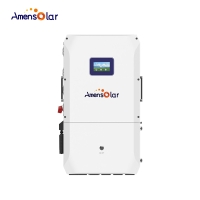US PV inverter market: Inventory and price trends under tariff impact
Recent U.S. import tariffs on photovoltaic (PV) equipment, including inverters, have not yet precipitated a sharp decline in inverter inventories due to substantial “pre-tariff” stockpiles that remain in the distribution pipeline. Inverters subject to the new duties have seen only modest price increases and steady inventory levels so far, but industry analysts anticipate a turning point later this year once those older stocks are exhausted, at which point both inventory levels and prices will climb. In terms of market share, grid-tie inverters continue to dominate, hybrid inverters are growing rapidly to meet rising energy-storage and backup-power needs, and off-grid inverters remain a niche segment with strong growth prospects in remote-power applications.

1. Impact of Tariffs on Inventory
1.1 High Initial Stock Levels
The U.S. government’s recent imposition of additional ad valorem and antidumping duties on imported PV modules, batteries, and inverters came into effect in April. These new duties were intended to drive up prices and reduce stockpiles of low-cost imports. However, because distributors and installers had already imported—and warehoused—large volumes of inverters before the tariff deadline, inventory levels have stayed elevated rather than plunging immediately.
1.2 Modest Price Adjustments
Although suppliers have incorporated the new tariffs into their wholesale price lists, the increases have generally been in the low-single-digit percentages. This muted price reaction reflects distributors’ reluctance to pass through the full cost bump to end customers until existing inventories are drawn down. Consequently, there has been little evidence of the “rush to buy” that one might expect from a sudden cost jump.
1.3 Anticipated Inventory Turning Point
Market observers forecast that once these pre-tariff stocks deplete—likely in the late second or early third quarter of 2025—inventory levels will begin to fall sharply. At that stage, the remaining inverters on hand will reflect higher landed costs, leading to steeper price increases and slimmer availability. Many installers and project developers are already planning their procurement schedules around this anticipated inflection.
2. Comparison of Inverter Types in the U.S. Market
2.1 Grid-Tie Inverters
Grid-tie inverters, which convert DC output from solar panels directly into AC power for export to the utility grid, remain the dominant choice for residential and commercial PV systems. In the United States, they account for nearly half of all inverter shipments. Their market appeal lies in their relative simplicity, cost-effectiveness, and direct integration with net-metering arrangements offered by many utilities.
2.2 Hybrid Inverters
Hybrid inverters combine grid-tie functionality with integrated energy-storage management, allowing solar arrays to both export to the grid and charge onsite battery banks. This dual-mode operation supports demand-charge management, backup-power provisioning, and time-of-use optimization. Fueled by growing homeowner interest in resilience and self-consumption, hybrid inverters have experienced double-digit annual growth and now represent roughly one-third of new installations in key regional markets.
2.3 Off-Grid Inverters
Off-grid inverters are designed for completely self-contained solar installations that operate independently of the utility grid. Although they constitute the smallest portion of the overall inverter market—typically under 10 percent—off-grid systems are gaining traction in rural electrification projects, remote telecommunications sites, and specialty applications like recreational vehicles and maritime vessels. The off-grid segment continues to grow at an annual rate exceeding that of grid-tie models, driven by elevated utility rates and expanding interest in energy autonomy.

 N3H-X16US 16KW | Split Phase |...
N3H-X16US 16KW | Split Phase |...  N3H-X12US 12KW | Split Phase |...
N3H-X12US 12KW | Split Phase |...  N3H-X10US 10KW | Split Phase |...
N3H-X10US 10KW | Split Phase |...  N3H-X8US 8KW | Split Phase | ...
N3H-X8US 8KW | Split Phase | ...  N3H-X5US 5KW | Split Phase | ...
N3H-X5US 5KW | Split Phase | ...  N1F-A3US 3KW | Split Phase | ...
N1F-A3US 3KW | Split Phase | ...  N1F-A12US 12KW | Split Phase |...
N1F-A12US 12KW | Split Phase |...  N1F-A6.5US 6.5KW | Split Phase ...
N1F-A6.5US 6.5KW | Split Phase ...  N1F-A6.2P 6.2KW | Single Phase...
N1F-A6.2P 6.2KW | Single Phase...  N1F-A6.2E 6.2KW | Single Phase...
N1F-A6.2E 6.2KW | Single Phase...  AMF16000 51.2V | 16KWH | Floo...
AMF16000 51.2V | 16KWH | Floo...  AMW10240 51.2V | 10.24KWH | W...
AMW10240 51.2V | 10.24KWH | W...  LFP 16kWh / LV 51.2V | 16KWH | Floo...
LFP 16kWh / LV 51.2V | 16KWH | Floo...  S52300 51.2V | 16KWH | Stac...
S52300 51.2V | 16KWH | Stac...  S52200 51.2V | 10.24KWH | S...
S52200 51.2V | 10.24KWH | S...  AML12-200 12.8V Series LifePo4...
AML12-200 12.8V Series LifePo4...  AML12-100 12.8V Series LifePo4...
AML12-100 12.8V Series LifePo4...  AML12-120 12.8V Series LifePo4...
AML12-120 12.8V Series LifePo4...  AML12-150 12.8V Series LifePo4...
AML12-150 12.8V Series LifePo4... 